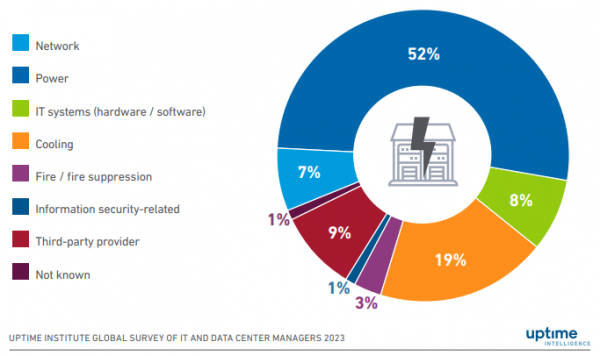Ensuring a continuous cooling system is paramount for data centers. Disruptions in cooling, triggered by factors like mains power interruptions or equipment failures, can lead to severe consequences. Overheating may result in server and network equipment malfunctions, causing interruptions in services and potential data loss. The repercussions extend beyond economic losses, posing a significant threat to a company’s reputation. Everyday online activities, such as browsing websites and using apps, can be marred by service interruptions, many of which stem from cooling failures in data centers. Research from the reputable Uptime Institute reveals that, in recent years, the failure rate of cooling systems has surpassed that of IT systems, emerging as the primary cause of data center outages after power supply and network failures.

Addressing Cooling Challenges in Small and Medium-Sized Data Centers
Effectively resolving service interruptions in data centers due to cooling failures remains a significant industry concern. While large-scale data centers have successfully tackled this issue through enhanced construction standards, robust disaster recovery systems, and improved emergency protocols, the scenario is different for small and medium-sized data centers. These smaller facilities, with their limited business scale and lower power density per cabinet, often lack continuous cooling capabilities. Consequently, they face a higher risk of experiencing downtime during power outages, particularly as the power demand per cabinet increases.
In recent years, incidents of service disruptions in small and medium-sized data centers caused by cooling system failures have become more frequent. This escalating trend of service interruptions due to cooling issues is evident. A small and medium-sized data center experienced server overheating and downtime for more than 3 hours, with the cooling system failing to restart multiple times.
Solving these continuous cooling challenges in small and medium-sized data centers is crucial to ensuring uninterrupted business operations and maintaining overall data center reliability.
A disruption in mains power occurs, causing downtime that is minimized to just a matter of “minutes.”
Conventional small and medium-sized data centers typically exhibit low equipment density, minimal server power, and an open layout. Factors such as cost, energy supply constraints, and limited space often lead to the absence of backup systems like condensation water towers and air-conditioning UPS, commonly found in larger data centers. Consequently, these smaller data centers lack cooling redundancy and disaster recovery mechanisms. In the event of cooling disruptions, they traditionally resort to leveraging the residual cold storage within the original computer room space, utilizing measures like opening windows for ventilation and employing fans to bridge the time gap until equipment restarts.
However, the landscape is evolving. The ongoing digital transformation across various industries has led to businesses migrating online, intensifying their dependence on uninterrupted online services. The ramifications of service interruptions are now deemed immeasurable. Simultaneously, due to business migration and the adoption of diverse digital tools, the computing power scale of small and medium-sized data centers has significantly increased, accompanied by a simultaneous rise in IT load and energy consumption. Consequently, a cooling failure can cause server temperatures to escalate to levels where normal operation becomes impossible within a matter of minutes.
A white paper titled “Temperature Rise in Data Centers During Cooling System Interruptions” reveals that, following the interruption of computer room cooling, the temperature at all locations reaches an unacceptable range in approximately 5 minutes. As IT loads increase, the stable operating time for high-power, high-density cabinets in the event of cooling disruptions is considerably shortened. Empirical data demonstrates that, for a traditional 3KW cabinet, the server thermal protection shutdown time is around 480 seconds after cooling loss. In comparison, a 4KW cabinet shortens this time to 300 seconds. Notably, when cabinet density reaches 8KW, the thermal protection shutdown time is further reduced to less than 240 seconds, just half of the time required for a 3KW cabinet.
Uninterrupted cooling is essential for the smooth operation of small and medium-sized data centers.
Ensuring continuous cooling has become a critical necessity for small and medium-sized data centers, especially as they evolve into more compact spaces with higher equipment density and increased server power. However, implementing continuous cooling solutions for these centers is a complex task. While industry-standard options like cold storage tanks and dedicated UPS for air conditioning are commonly employed, they may not be suitable for smaller data centers.
Cold storage tanks, typically utilized in large water-cooled data centers, present challenges for smaller spaces. Their substantial size, often around 10 meters in diameter and tens of meters in height, is impractical for many small and medium-sized data centers located in constrained environments such as office buildings and base stations.
Another proposed solution involves integrating a separate UPS into the cold storage system to address cooling interruptions caused by sudden power outages. However, traditional small and medium-sized data centers often use lower-power UPS and fixed-frequency air conditioners with larger starting currents. Considering the considerable starting current of air-conditioning equipment, the UPS capacity needs to be 6 to 8 times that of the air-conditioning power, resulting in a substantial increase in the construction and investment of computer rooms. This approach, however, is rarely implemented in practical computer room scenarios.
A more practical solution in the current context involves utilizing a variable frequency precision air conditioner equipped with a UPS and battery backup. However, this approach comes with its own set of considerations. As a power equipment, the precision air conditioner generates harmonics during operation, necessitating the addition of measures for harmonic suppression or compensation. Given that power equipment, such as air conditioners, typically experience higher failure rates compared to electronic information equipment, using a UPS to power the air conditioner requires careful consideration. In the event of an anomaly, such as a sudden short circuit in the air conditioner, swift fault isolation is crucial to prevent any adverse impact on other equipment downstream from the UPS.
In light of these challenges and evolving application scenarios, small and medium-sized data centers must identify a continuous cooling solution tailored to their specific needs. This imperative aligns with the broader industrial development goals and plays a vital role in ensuring the smooth progression of the digitization process.
The adoption of efficient and reliable refrigeration technology, coupled with the establishment of a comprehensive continuous refrigeration mechanism, becomes paramount. This approach not only guarantees the uninterrupted and stable provision of services in small and medium-sized data centers but also enhances the overall user experience.
Media Contact
Universal Smart Data Center Technology
Phone: (+84) 28 73080708
Email: info@usdc.vn


